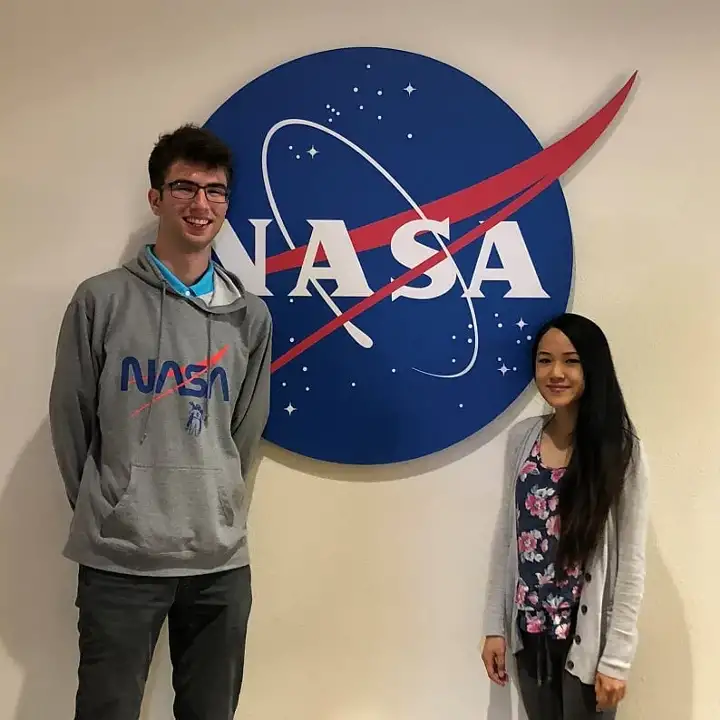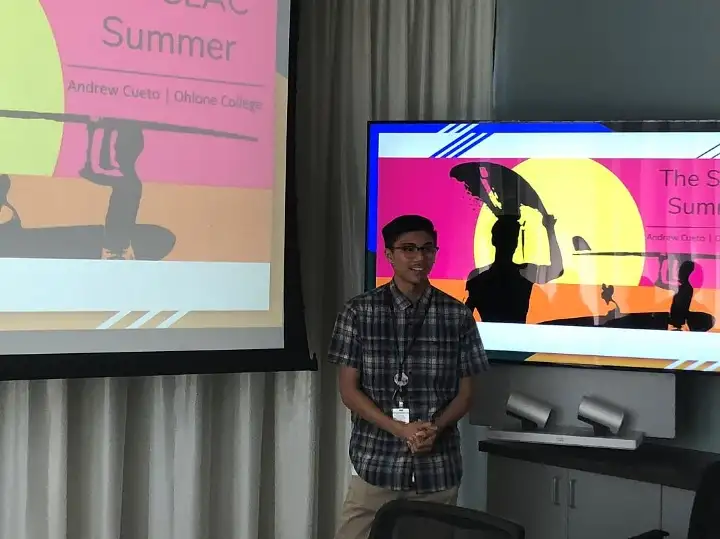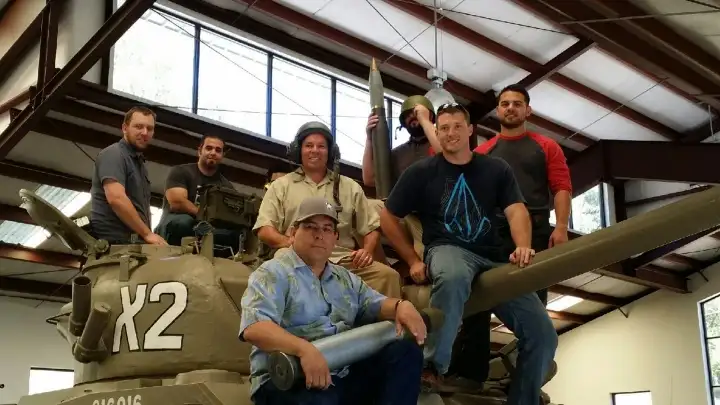SRI team finds a great opportunity in the summer’s rapid growth in STEM virtual internships

Some STEM employers saved summer internship programs with a quick pivot to virtual. But how did that go? An NSF-funded study is finding out, with the goal of helping STEM virtual internships work better for more employers and students next summer and beyond.
By May 2020, nearly four in ten college students had reported their summer 2020 internships were canceled or delayed, in a survey by the National Association of Colleges and Employers. Surprisingly, almost as many reported plans to participate in virtual internships.

STEM Core students Jennifer Chang and Ian Phelps look delighted to be in the office during their 2018 internship at NASA Ames Research Center. Credit: Marina Gonzalez, Ohlone College
NASA’s Jet Propulsion Laboratory, or JPL, was among those that honored its commitments to students by rapidly designing a new virtual internship program. JPL hosted over 600 students in the new program — nearly all those they had accepted prior to going virtual, JPL reported. Proctor & Gamble similarly moved ahead with remote experiences for around 570 students in a newly designed program. SRI also had nearly all of its 50 interns work remotely this summer, as we recently shared.
“At SRI, honoring our commitments to our interns is very important, as is ensuring that each intern received a meaningful and productive experience while remaining safe by working remotely,” comments Monique d’Almeida, Interim Associate Director, Talent Acquisition at SRI. “To that end, we planned events to keep the interns engaged, while giving them opportunities to hear from and work with our technical experts. The interns also had the opportunity to meet and converse with the CEO of the organization.”
Employers like these had only a few weeks to convert in-person internships to virtual experiences, and no best practices to follow.
Virtual internships are not new. The U.S. State Department’s Virtual Student Federal Service started in 2009 and now serves as a hub that connects other federal agencies with remote interns. On a smaller scale, virtual internships in engineering and computer science have been around since at least 2014.
But little is known about how to make virtual internships successful for both employers and students. The team behind a new study, funded by the National Science Foundation’s INCLUDES initiative and led by the STEM Core Expansion Alliance, wants to change that.

Ohlone College STEM Core student Andrew Cueto had a live audience when presenting on his 2019 internship at the SLAC National Accelerator Laboratory. Credit: Enrique Cuellar, SLAC
Never a better time to study virtual internships
This summer’s rapid rise in virtual internships offers a perfect opportunity to learn more, says study lead Kea Anderson, a senior researcher in SRI Education. “By hearing what went well and what people would do differently next time, we hope to develop guidance employers and students can use moving forward,” Anderson says.
Anderson and her team are especially interested in learning how STEM virtual internships can expand opportunities for students who cannot easily complete in-person internships, such as students with disabilities, rural students, or others with limited transportation or other obligations during traditional work hours.
But Anderson recognizes the value proposition has to be clear for employers as well. “What do employers gain by offering virtual internships, even once it’s safe to resume traditional, in-person programs? How can more employers be incentivized to participate? We hope to answer these questions,” she says.
As some companies announce employees will continue to telework through July 2021 and others announce employees will do so indefinitely, virtual internships may remain the best option for many STEM employers and students, even after the pandemic has passed.
Employers and students, please share your experience with STEM virtual internships in SRI’s short employer survey or student survey. Anyone who takes a survey can request a copy of the study findings, available January 2021, right in the survey“
Idea for national study started with a STEM Core challenge
Anderson and her team — co-lead Carol Tate and researchers Victoria Sosina, Elise Levin-Guracar and Christopher Ortiz — first saw the need for a virtual internship study back in the spring, as canceled internships began affecting STEM Core students’ summer plans.
STEM Core is a network of community colleges and STEM employers that aims to help students who start college underprepared in mathematics get ready for calculus in just one year. Students who can take calculus in their second year of community college can pursue a range of STEM careers and transfer to engineering or other STEM programs at four-year schools. STEM Core opens options for them that would otherwise remain out of reach, while also helping address critical U.S. workforce needs, such as for engineering technologists and engineering technicians at national laboratories.
Participating students work as a cohort to take accelerated math classes and an associated STEM class, often engineering or computer science. A dedicated staff member provides wraparound support and works with area employers to host company visits and help broker paid internships — when employers are offering them.
The STEM Core team tries to broker paid internships for students after their first year, said Gabe Hanzel-Sello, National STEM Director at STEM Core network leader Growth Sector. “We have seen that earlier industry experience provides valuable context for subsequent coursework and helps students stay motivated when courses get challenging,” he said.
Hanzel-Sello was used to creatively encouraging employers to take on first-year students, including raising grant funds to cover intern stipends and hiring community college instructors to provide additional mentoring. But the pandemic presented new challenges.
Despite all efforts, not all STEM Core students found career-related alternatives to canceled internships. “It was heartbreaking,” said Hanzel-Sello. “They had worked so hard to complete these rigorous courses and were really looking forward to gaining industry experience,” he said, adding that paid internships also mean students can leave retail and service jobs to focus on career preparation.
When the SRI study team saw students who did have internships showcase their work in an Ohlone College program, they became more concerned about what students with canceled internships were missing. A 2019 NACE survey of over 3000 graduating seniors found that students who had paid internships received nearly 50 percent more job offers and expected to earn $10,000 more a year than students who had not had paid internships.

Caption: Are some internships harder to do virtually? Las Positas College STEM Core Engineering Tech students Michael Urrueta, Jeremy Taylor, Stephen Leahy, Fernando Campos, Howard Layton, and Logan Bekker work with Lawrence Livermore National Lab’s Randy Pico in their 2015 internship. Credit: LLNL
As canceled internships — and quickly mounted virtual internship programs — became national news, the SRI study team realized that a national study of STEM virtual internships could potentially help STEM Core attract more virtual internship offers for its students next summer while also providing much-needed guidance to STEM employers around the country.
SRI Education is evaluating the STEM Core network as part of an NSF INCLUDES Alliance grant, focusing on how and why the STEM Core model varies college to college, and factors that help and hinder network expansion and network strength.
Questions about the STEM virtual internship study can be directed to principal investigator Kea Anderson or to SRI’s Institutional Review Board at irb@sri.com. The team is collecting survey responses through October 15, 2020.



